Atelier BOOM-TOWN: Nestled on the south side of Mount Shefford (Québec, Canada), this residence is divided into three main volumes that follow the curves of the land. The volume that is slightly embedded in the mountain, on the rear façade, houses a ceramic workshop and a garage. A smaller volume, clad in Corten steel, is occupied by the master bedroom, its bathroom, and storage spaces. A home theater room is located below. The main volume faces due south, with a large opening on two levels that open onto the forest and Mount Bromont in the distance. The roof extends to the west to cover the outdoor terrace. On the east side, a rooftop terrace, accessible from a secondary room, is laid on the Corten block.
The variable width, white cedar siding helps to integrate, and even hide, the house in the forest, while the oxidation of the Corten block picks up the iron rocks present in this part of the mountain. The grey steel roof envelops the entire north façade, protecting the forms of the house from the road above.
This project houses the studio of ceramist Sophie Manessiez, who lives there with her partner Damien and their children. It is a meeting place between domestic, work, and creative spaces.

It is also a place of gathering and greeting for family and friends. The openings in these spaces allow singular relationships with the landscape and surrounding nature. Sometimes generous, sometimes more intimate, these multiple openings offer specific views and adapted sunlight so that the work spaces open onto different panoramas from those offered to the family areas. Sunlight, like nature, penetrates the spaces from all sides, positioning the occupants at the center of an encounter between architecture and nature. The ground floor terrace extends the main space to the exterior.
From the first meetings, it was important for the clients to have a house with a human dimension, as well as a reasoned ecological footprint. Particular attention was therefore paid to the orientation of the house in order to integrate some elements of passive solar design using the thermal mass with the floor slab and the openings to the south, while using different methods to create sunbreakers on the south facade to avoid overheating in summer. The fenestration also allows for cross ventilation. The wall insulation was improved with compositions of up to R46 insulation value, as well as roofs of R62 value, thus minimizing the operating costs of the house.


















About atelier BOOM-TOWN
Historically, a Boomtown house has been associated with ‘mushroom’ towns created near industrial complexes and mines in the years 1890–1920. It is easily recognized by its simple facade and square shape. Its roof is flat, or nearly flat, which was an innovation for the time. The popularity of the Boomtown house was mainly due to its increased space and low construction costs.
A century later, l’atelier Boomtown proposes a rereading of the architecture of human-scale buildings, based on the original principles of the Boomtown house: Simplicity and efficiency. Working with space, light, and matter, l’atelier Boomtown designs contemporary houses, adapted to modern living.





